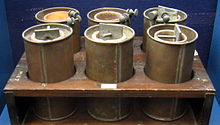Daniell element
The Daniell cell (also Daniell'sches element ) is a historical galvanic cell consisting of a zinc - and a copper - half cell is composed. It is named after John Frederic Daniell , who developed it in 1836.
construction
A zinc rod ( Z in the picture) inside the cell is immersed in a solution of dilute sulfuric acid . This was located in historical forms in a container made of porous earthenware (P), which in turn was immersed in a concentrated or even better saturated solution of copper sulfate in the outside area . The second copper electrode, C , designed as a cylindrically bent sheet of copper, is immersed in the copper sulphate solution . The entire cell is housed in an outer container J.
The diaphragm, also known as the salt ladder or salt bridge , and in the original design in the form of a pot made of earthenware, serves to prevent the diffusion mixing of the different metal cations from the two solutions and still enable a charge equalization through anions through the porous material.
In the original design with earthenware as a diaphragm is the internal resistance of a cell around 10 Ω , which element at a voltage of 1.1 V a maximum discharge current in the range of 100 mA permits. To avoid this high internal resistance, various Gravity-Daniell elements were developed, which omit the porous diaphragm as the main difference. The securing of the sulphate solutions arranged vertically one above the other is achieved in various constructive approaches such as the Meidinger element , Callaud element or Lockwood element through different densities of the sulphate solutions and through gravity .
To produce a Daniell element whose voltage corresponds to the difference between the standard potentials , a zinc sulphate solution and a copper sulphate solution with an activity of 1 mol per liter each should be used; the concentrations can be approximately 1 mol per liter instead. For a potential measurement, the connection of the two sulfate solutions in separate containers can also be connected via a special U-tube with a diaphragm as an ion conductor . If the difference between the standard potentials is not to be measured, but rather the highest possible voltage and the highest possible capacitance are to be achieved, the copper sulfate concentration is selected as high as possible; H. the solution becomes saturated and should contain CuSO 4 that is still undissolved if possible . For the sake of simplicity, a solution of zinc sulfate is often used on the zinc side. If, on the other hand, the goal is to achieve the highest possible voltage with a new cell, the zinc concentration must be selected as low as possible, i.e. That is, when building the cell on the zinc side, pour diluted sulfuric acid or a sodium sulfate solution. The sulfuric acid must be diluted, otherwise zinc will dissolve with evolution of hydrogen.
function

Zinc has a lower standard potential than copper, i.e. That is, zinc is less noble than copper and the dissolution tension of zinc is greater. This is why a relatively large number of zinc ions go into solution on the zinc rod, while only relatively few copper ions detach themselves on the copper rod and leave their electrons behind in the metal. In the zinc electrode , the negative pole and in this case the anode , more electrons are left behind, which is why it is more negatively charged than the copper rod, which means the build-up of an electrical voltage.
The excess electrons in the oxidizing zinc (Zn) migrate from the zinc to the copper (Cu) via a conductor. A voltage of 1.10 V can be measured under standard conditions. This is the electrical source voltage , which is composed of the redox potential of copper ( E 0 (Cu) = +0.34 V) and that of zinc ( E 0 (Zn) = −0.76 V).
The dissolved copper ions absorb the electrons and deposit themselves as copper on the electrode, in this case the cathode . Since positive zinc ions go into solution on the one hand and copper is deposited on the other, a charge equalization must take place. Sulphate anions [SO 4 ] 2− migrate over the salt bridge to the anode compartment and zinc cations Zn 2+ migrate in the opposite direction. This closes the circuit.
The two partial processes of the redox reaction can therefore be spatially separated. The electrons do not go directly from the Zn / Zn 2+ system to the Cu / Cu 2+ system , but first migrate from the zinc to the copper via a wire. A stream of electrons flows.
The two separate subsystems are called “half cells”. The zinc electrode dissolves over time as a result of corrosion , while the copper electrode increases in mass. There are 2 redox pairs (Zn / Zn 2+ and Cu / Cu 2+ ).
Reaction equation:
- Cell diagram: Zn / Zn 2+ // Cu 2+ / Cu
- Reduction:
- Oxidation:
- Overall reaction (redox reaction):





